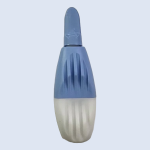Need Help?
Ask an expert
1. How to collect DBS HbA1c
APPROVED DRIED BLOOD SPOTS COLLECTION METHOD
Dried Blood Spots Collection Handbook
Collection volume, general considerations, and basic guidelines to maximize Dried Blood Spot sample integrity. Use this handbook to plan you collection methodology and sampling schemes.

2. How to Assay Dried Blood Spots for HbA1c
Send Dreid Blood Spot Samples to Salimetrics
Add to StudyEasy and accurate results from the Salimetrics CoreLab+ Laboratory.
Order Code5211.06
3. Technical Summary
| Analyte Summary: | |
|---|---|
| Analyte: | Hemoglobin A1c |
| Aliases: | HbA1c |
| DBS-Whole Blood Correlation: | 0.93 |
| Optimum Collection Volume: | 3 Full Spots |
| Assay Summary: | |
|---|---|
| Methodology: | HPLC |
| Sensitivity: | 3.9% |
| Assay Range: | 3.9%–18.8% |
| Assay Type: | Quantitative |
Background
Hemoglobin A1c is a robust biomarker for long-term glycemic control, reflecting average blood glucose concentrations over the lifespan of erythrocytes (~2-3 months). It is widely used in epidemiological and clinical research for the assessment of diabetes risk and management. Elevated HbA1c levels are associated with increased risk of microvascular and macrovascular complications, making it a critical marker for researchers studying metabolic health, particularly in the context of obesity, insulin resistance, and diabetes. Using dried blood spots for HbA1c quantification provides a practical and scalable method for researchers investigating metabolic health outcomes across diverse populations. The frequent and convenient collection of DBS can facilitate monitoring of HbA1c trends in response to behavioral interventions, providing a clearer understanding of the impact of lifestyle changes on glycemic control over time. The Salimetrics Core Lab is supported by the latest advancements in DBS analysis, as demonstrated in published research, including the work of Thomas McDade, Ph.D., who also serves as a scientific advisor for DBS studies. This ensures that Salimetrics’ methodologies align with the expected performance standards established by experts in the field.
References & HbA1c DBS Research
-
- Affan, E. T., Praveen, D., Chow, C. K., & Neal, B. C. (2014). Comparability of HbA1c and lipids measured with dried blood spot versus venous samples: A systematic review and meta-analysis. BMC Clinical Pathology, 14, 21.
- Bonetti, P. O., Lerman, L. O., & Lerman, A. (2003). Endothelial dysfunction: A marker of atherosclerotic risk. Arteriosclerosis, Thrombosis, and Vascular Biology, 23(2), 168–175.
- Crimmins, E., Faul, J., Kim, J. K., Guyer, H., Langa, K., Ofstedal, M. B., Sonnega, A., Wallace, R., & Weir, D. (2014). Validation of blood-based assays using dried blood spots for use in large-scale population studies. Journal of Gerontology: Series B, 69(1), 1–9.
- Fokkema, M. R., Bakker, A. J., de Boer, F., Kooistra, J., de Vries, S., & Wolthuis, A. (2009). HbA1c measurements from dried blood spots: Validation and patient satisfaction. Clinical Chemistry and Laboratory Medicine, 47(10), 1259–1264.
- Hall, J., Fowler, C., Pollock, A., & MacRury, S. (2020). Haemoglobin A1c determination from dried blood spots prepared with HemaSpot blood collection devices: Comparison with fresh capillary blood. Clinical Chemistry and Laboratory Medicine, 59(2), e79–e82.
- Hu, P., Edenfield, M., Seeman, T., & McDade, T. W. (2015). Validation and modification of dried blood spot-based glycosylated hemoglobin assay for the Longitudinal Aging Study in India. American Journal of Human Biology, 27(4), 553–555.
- Little, R. R., Rohlfing, C. L., & Sacks, D. B. (2011). The National Glycohemoglobin Standardization Program: Over 20 years of improving HbA1c measurement. Clinical Chemistry, 57(2), 205–214.
- Mastronardi, C. A., Whittle, B., Tunningley, R., Neeman, T., & Paz-Filho, G. (2015). The use of dried blood spot sampling for the measurement of HbA1c: A cross-sectional study. BMC Clinical Pathology, 15, 13.
- McDade, T. W., Williams, S., & Snodgrass, J. J. (2007). What a drop can do: Dried blood spots as a minimally invasive method for integrating biomarkers into population-based research. Demography, 44(4), 899–925.
- McDade, T. W., & Williams, S. (2006). The use of dried blood spot sampling in the National Social Life, Health, and Aging Project. The Journals of Gerontology: Series B, 61(3), S131–S136.
-
- McDade, T. W., & Williams, S. (2006). Dried blood spots as a minimally invasive method for integrating biomarkers into population-based research. IPR Working Paper Series, Northwestern University.
-
McDade, T. W., & Williams, S. (2006). HPLC-based measurement of glycated hemoglobin using dried blood spots. Duke University.
- Williams, S. R., & McDade, T. W. (2006). The use of dried blood spot sampling in the National Social Life, Health, and Aging Project. The Journals of Gerontology: Series B, 61(3), S131–S136.
- Sacks, D. B. (2011). A1C versus glucose testing: A comparison. Diabetes Care, 34(2), 518–523.
- Sherwani, S. I., Khan, H. A., Ekhzaimy, A., Masood, A., & Sakharkar, M. K. (2016). Significance of HbA1c test in diagnosis and prognosis of diabetic patients. Biomarker Insights, 11, 95–104.
- World Health Organization. (2011). Use of Glycated Haemoglobin (HbA1c) in the Diagnosis of Diabetes Mellitus: Abbreviated Report of a WHO Consultation. Geneva: World Health Organization.
- McDade, T. W., & Williams, S. (2006). Measurement of psychosocial factors and biomarkers in population-based studies using dried blood spots. Annals of the New York Academy of Sciences, 1083, 361–374.
- Issa, R., Feinglass, J. M., Schwartz, W. A. H., & Jacobson, T. A. (2025). Investigating psychosocial factors and systemic inflammation using dried blood spots: A scoping review. Psychosomatic Medicine.
- Shim, H., Ailshire, J., Potter, A., Cofferen, J., & Faul, J. (2019). Dried blood spots: Effects of less than optimal collection, shipping time, heat, and humidity. BMC Clinical Pathology, 19(1), 1–8.
-
Anderson, C., Fry, R. C., Hartwell, H. A., & Nichols, H. (2021). Measurement of mitochondrial DNA copy number in dried blood spots: A pilot study. Mitochondrion, 56, 1–4.
 Contact: Salimetrics (USA)
Contact: Salimetrics (USA)




